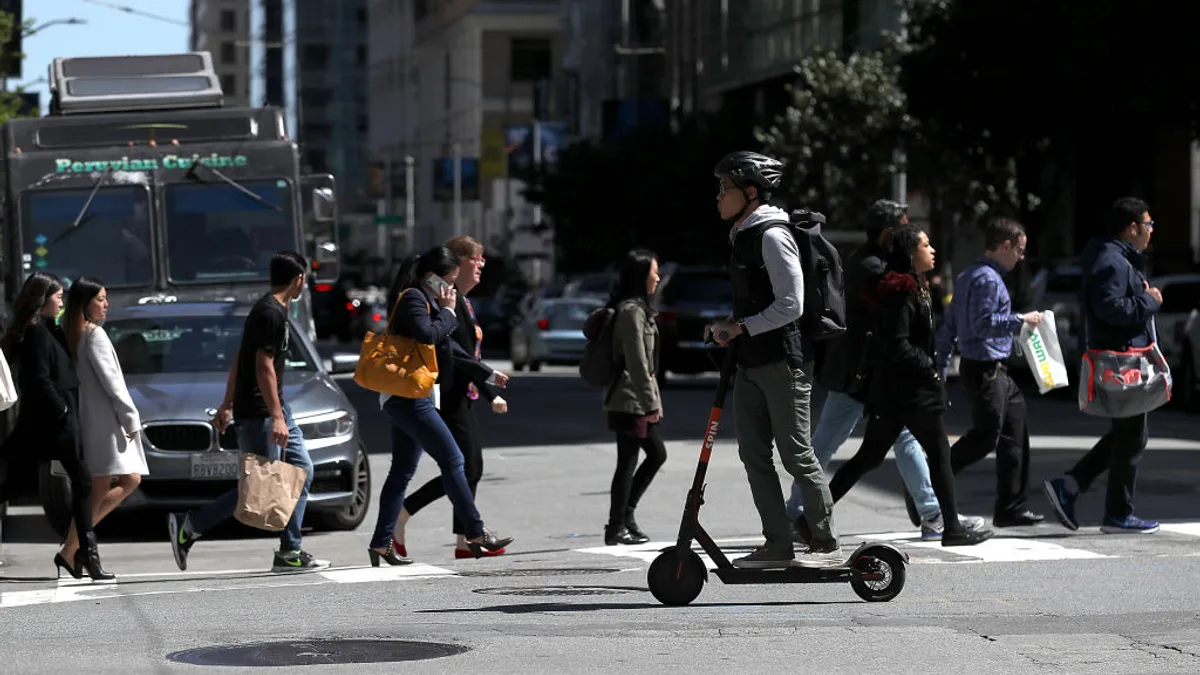CHICAGO – At the 1939-1940 New York World Fair, 5 million people walked away from the event with a glimpse into the future. Or at least a version designed by General Motors.
Visitors to the GM “Futurama” exhibit took a ride-like experience through a new vision of the relationship between cities and cars. Attendees even walked away with buttons that read, "I have seen the future.”
A little over 80 years later, mobility leaders gathered in Chicago at the National Shared Mobility Summit last week to discuss how to sell U.S. residents on a less car-centric future, in addition to solutions for providing more accessible and racially equitable shared mobility options.
The U.S. became dependent on cars because residents were sold a very attractive transportation future, said historian Peter Norton, an associate professor at the University of Virginia, at the conference. But shared mobility leaders need to recognize that they also have an attractive future to offer, he said.
In light of incoming federal investments for local infrastructure, many conference speakers emphasized the need to support shared mobility by first ensuring that basic infrastructure needs are being met.
“For me, innovation is an accessible sidewalk,” said Disability Rights Education & Defense Fund Government Affairs Liaison Carol Tyson. Innovation is about having a bench at a bus stop and accessible pedestrian signals and curb ramps, Tyson said.
Local governments have historically struggled to provide basic infrastructure like crosswalks or subway stations that are compliant with the Americans with Disabilities Act. Baltimore, for example, is among the cities that have recently been sued over ADA violations.
Tyson encouraged local leaders to leverage the infrastructure law — including its $6 billion allocations for Safe Streets and Roads for All grant program for local governments — to help invest in those areas.
Panelists also emphasized the urgent need for racial equity within mobility, which includes addressing how cities enforce traffic laws.
Equiticity President and CEO Olatunji Oboi Reed noted that young Black and brown people have shared that they don’t feel safe cycling in Chicago due to police enforcement. Chicago police have historically issued sidewalk cycling tickets in Black and Latino neighborhoods more frequently than in White neighborhoods, the Chicago Tribune reports.
As the National Highway Traffic Safety Administration issued another grim report last week about rising traffic deaths in 2021, Reed urged conference attendees to reevaluate the role of police enforcement in Chicago's Vision Zero plans.
There are other ways to reduce traffic violence without the harm of a police enforcement strategy, Reed said. The Chicago region is years behind other cities that are actively trying to remove police from their strategy, he said.
Cities including Brooklyn Center, Minnesota, and Berkeley, California, have recently reconsidered the role of police officers in traffic enforcement. Many safety and transportation groups, including the Governors Highway Safety Association, have also supported a “safe system” approach that “acknowledges human error and seeks to minimize fatalities and serious injuries.” Meanwhile, other transportation leaders have called on city officials to look at how street design and speed limit policies could help encourage safe driving instead of relying on police enforcement.
Community engagement was also discussed as a solution to addressing both racial inequities and accessibility issues on city streets.
Community-based organizations should be a critical part of the transportation planning process to lead to better and more vibrant outcomes, Reed said.
“Who should be driving the [transportation planning] vision process?" Reed asked. “Should it be the White people at the DOT downtown who rarely come to our neighborhoods… or should it be Black and brown people [and] community-based organizations who are in our communities every single every day?”
Community outreach is the key to doing more equitable work, said Heidy Persaud, director of transportation equity at the nonprofit Center for Neighborhood Technology. Transportation leaders need to go out and talk to community members and understand what it is they are asking for, she said.
Several panelists also emphasized the importance of compensating community members for their input and collaboration. Compensation allows community members to participate more fully in various projects, Persaud said.
Seattle’s Department of Transportation and its Office of Planning and Community Development, for example, announced last year that both would offer $5,000 to community-based organizations and small businesses for participating in a planning development process. Other researchers have provided community members with fresh produce and grocery store gift cards.




















